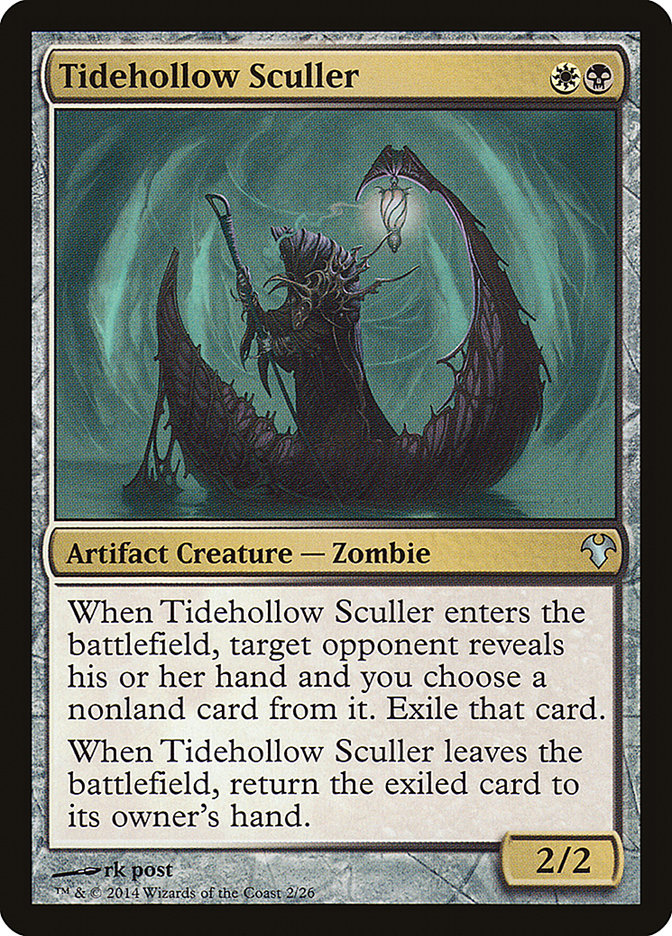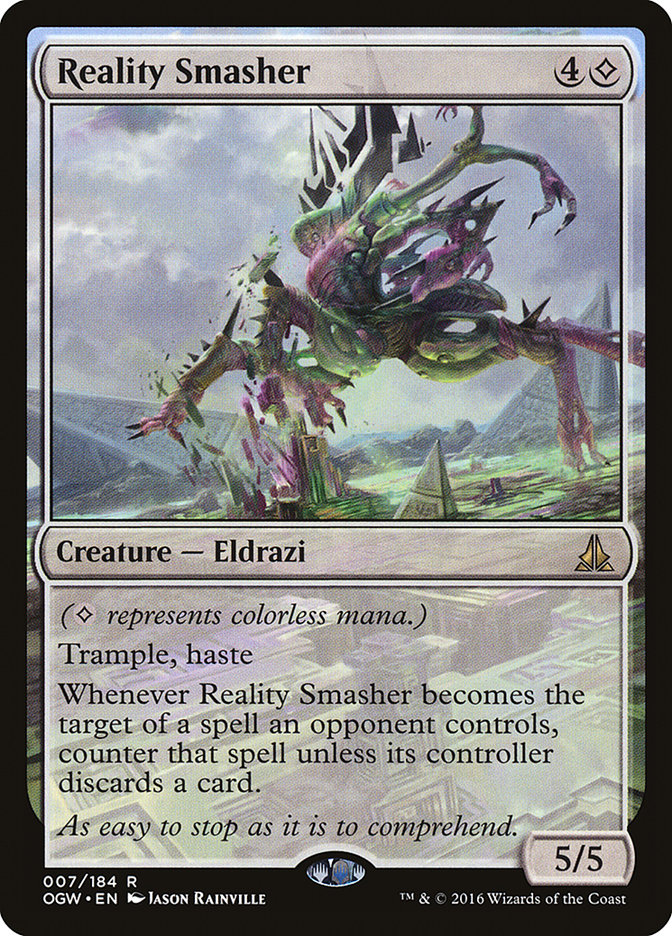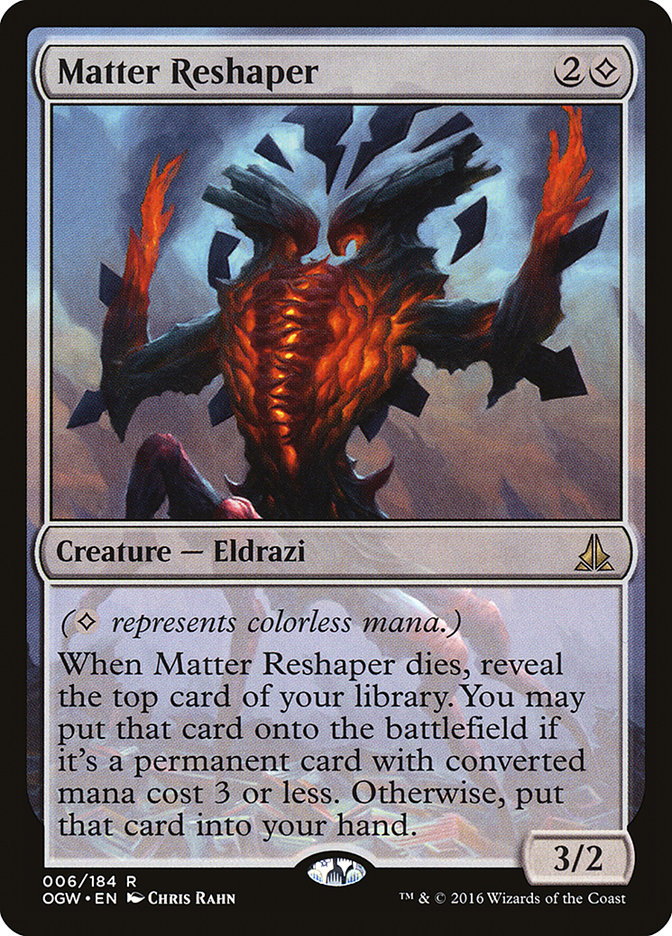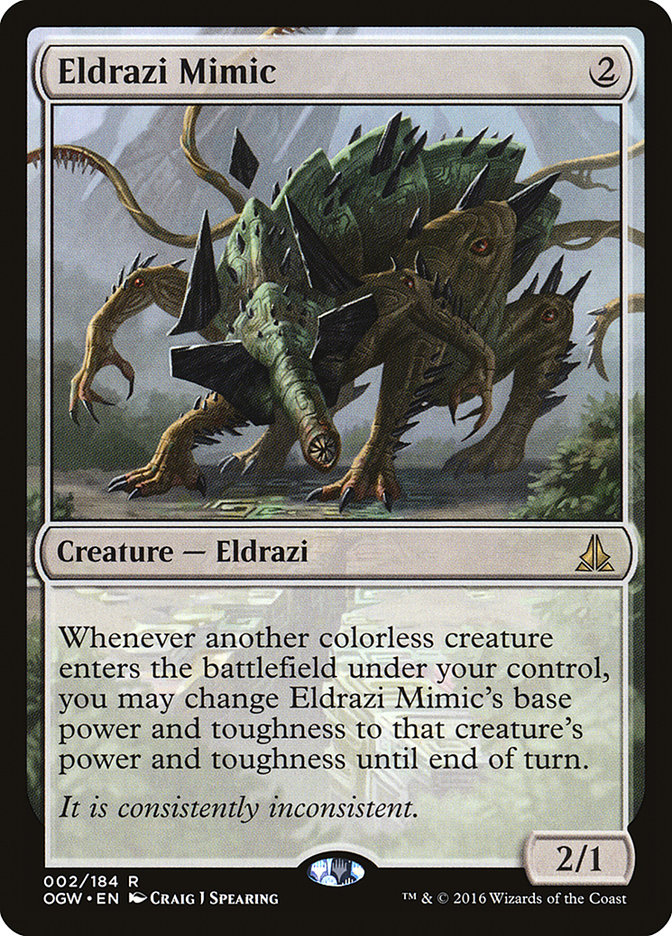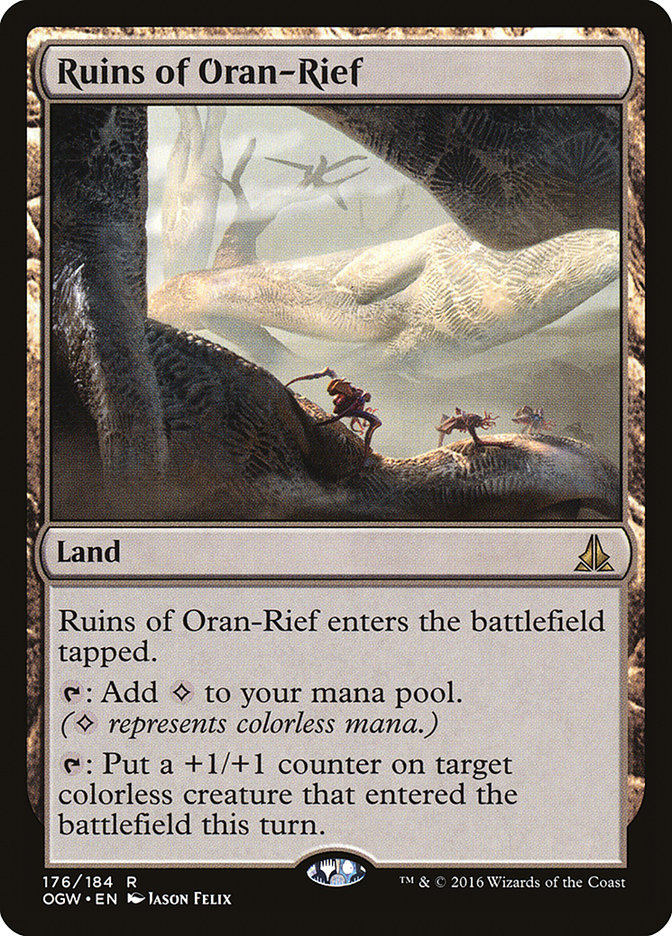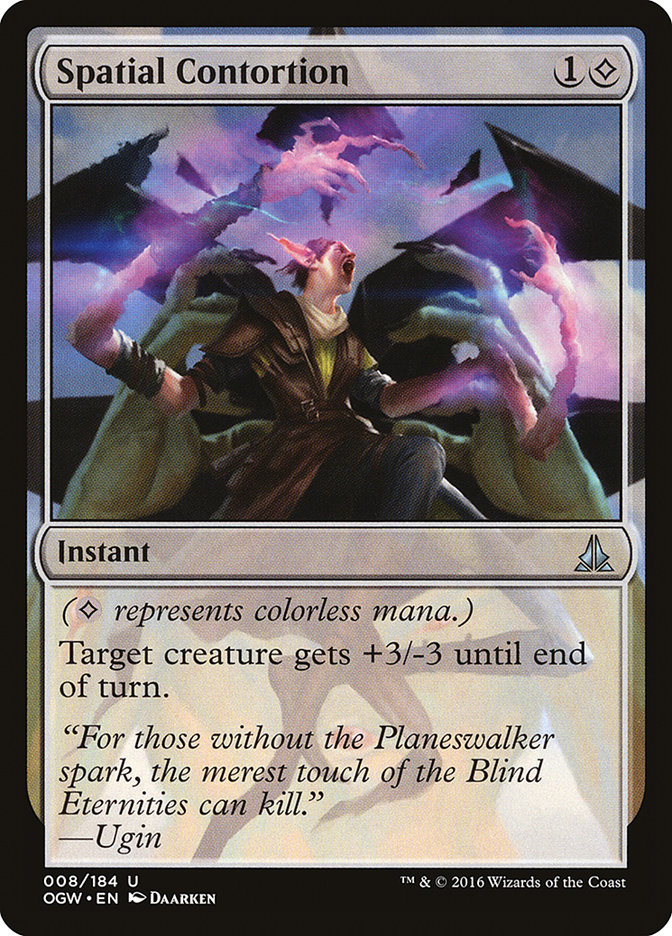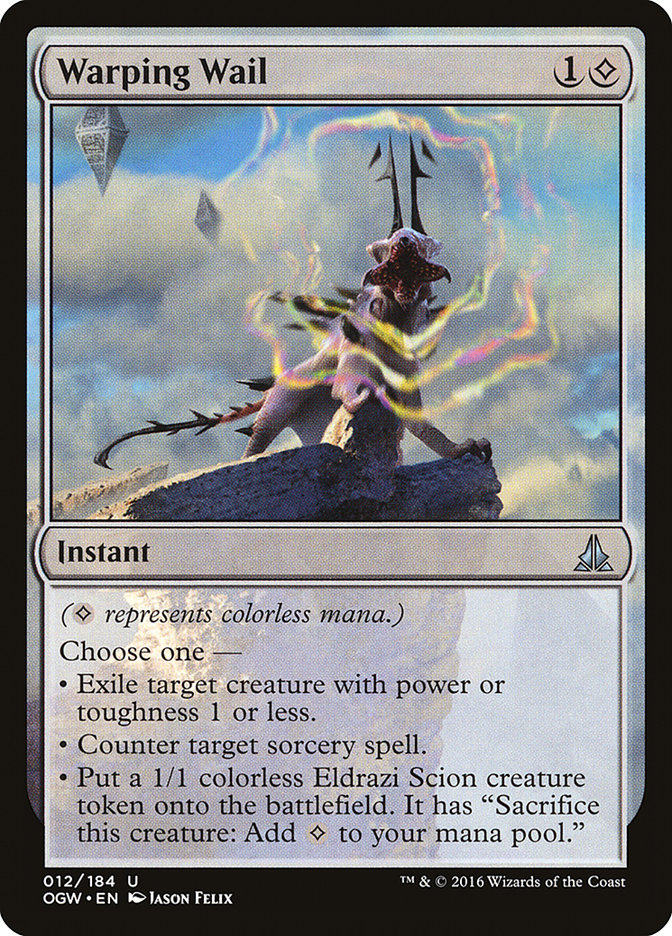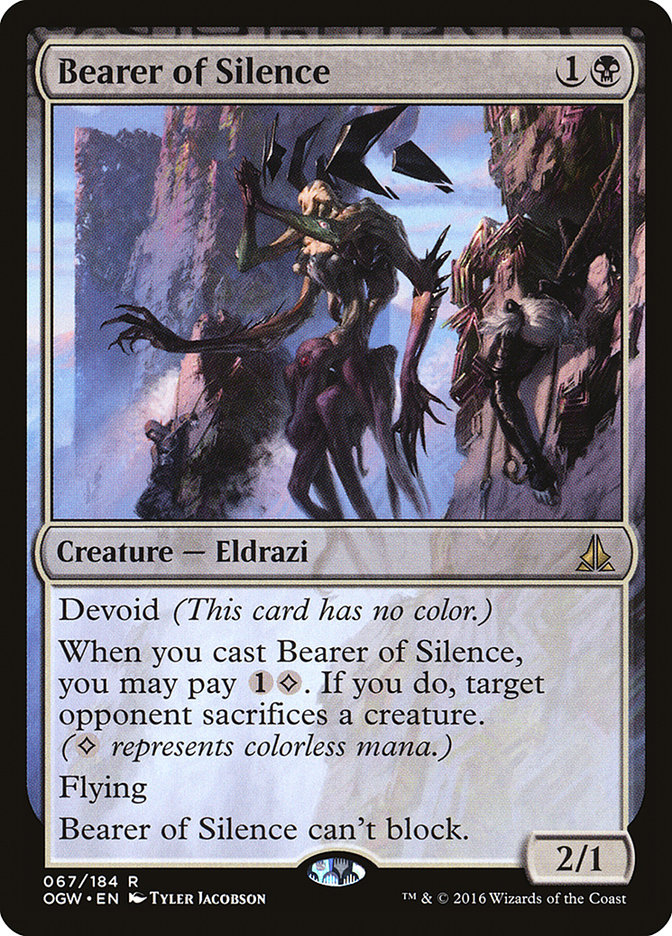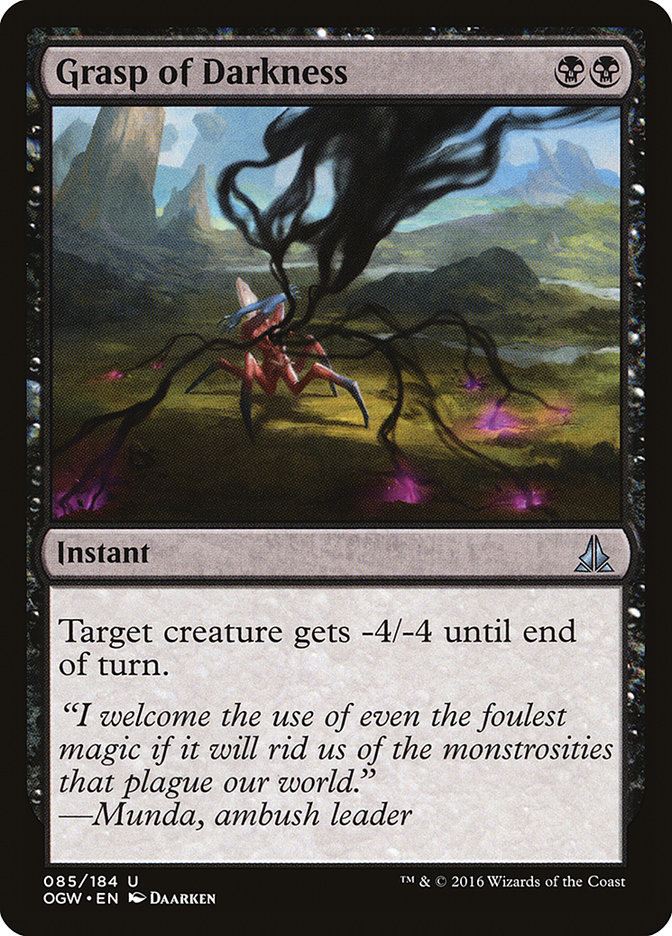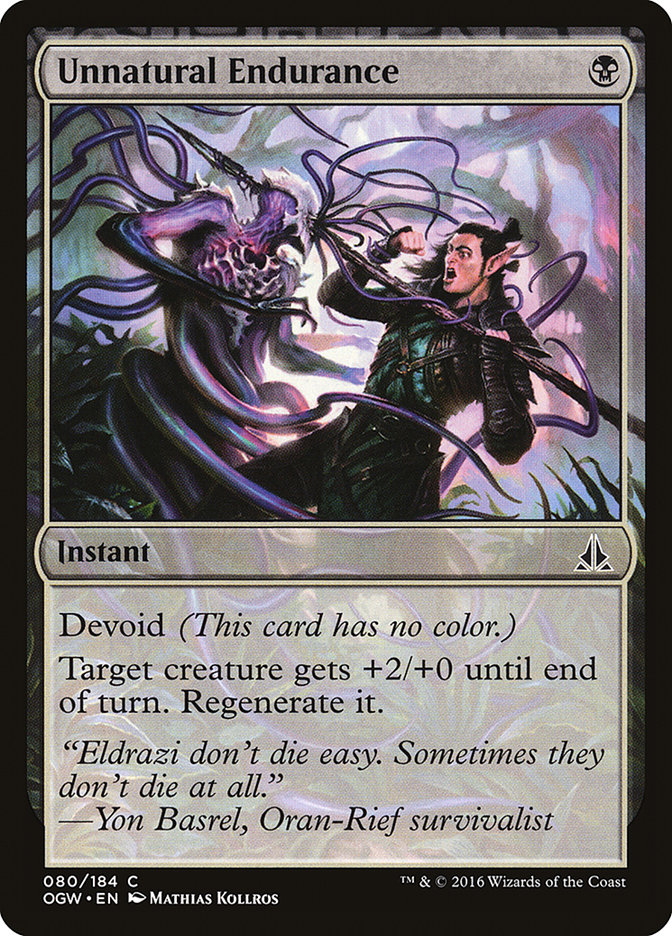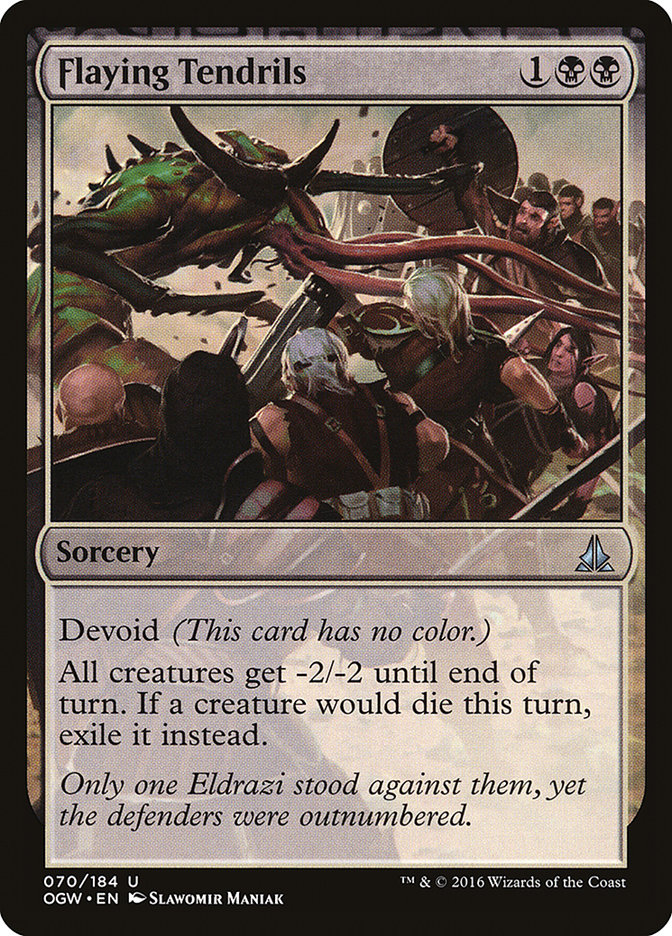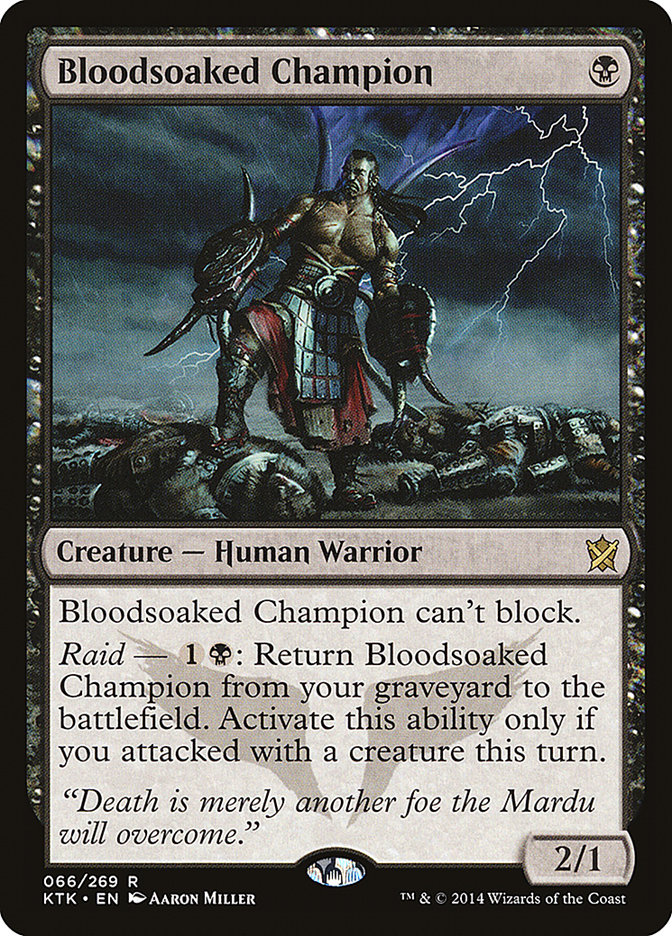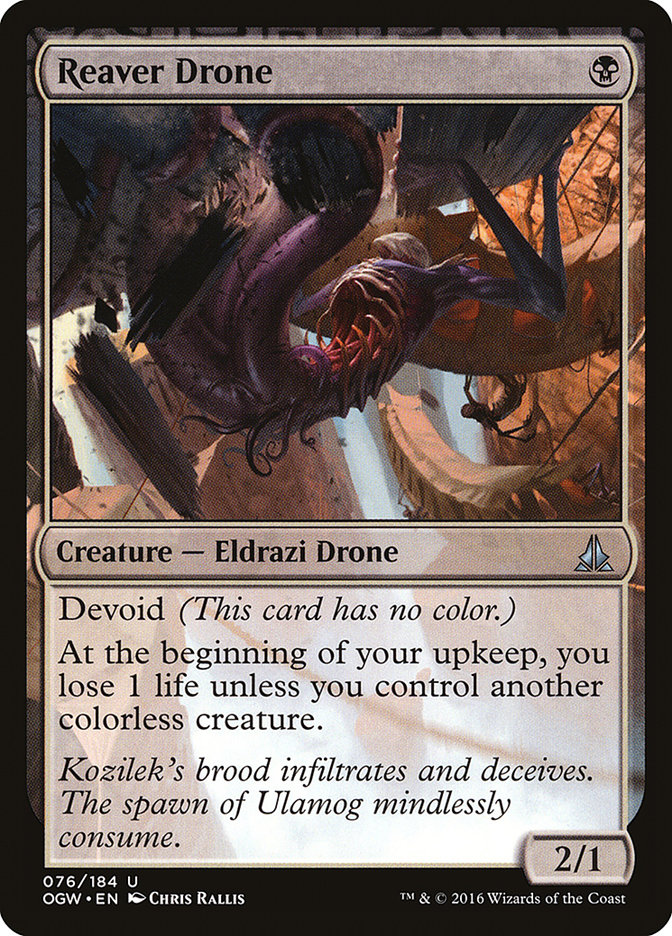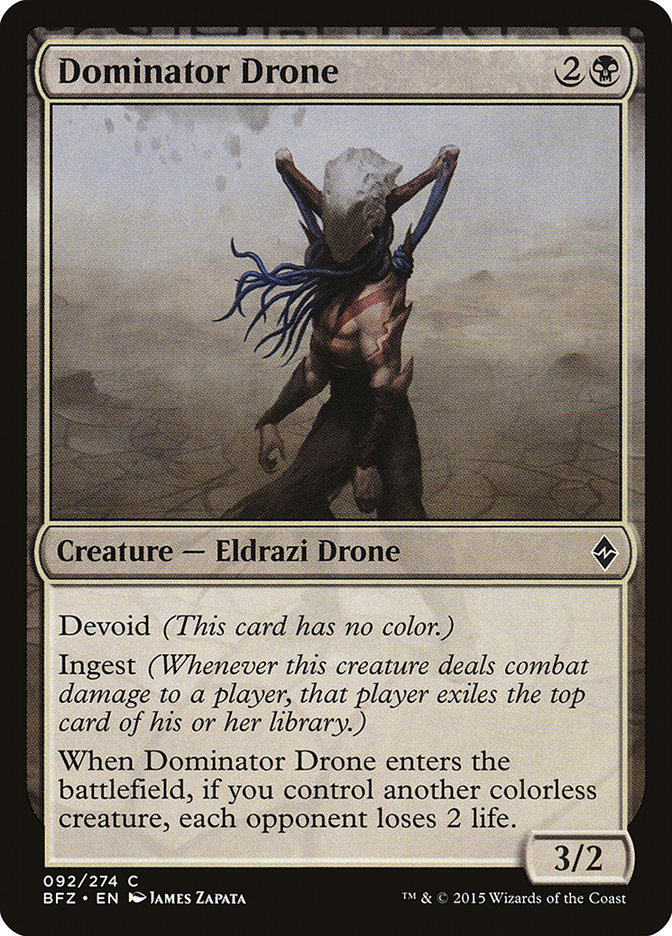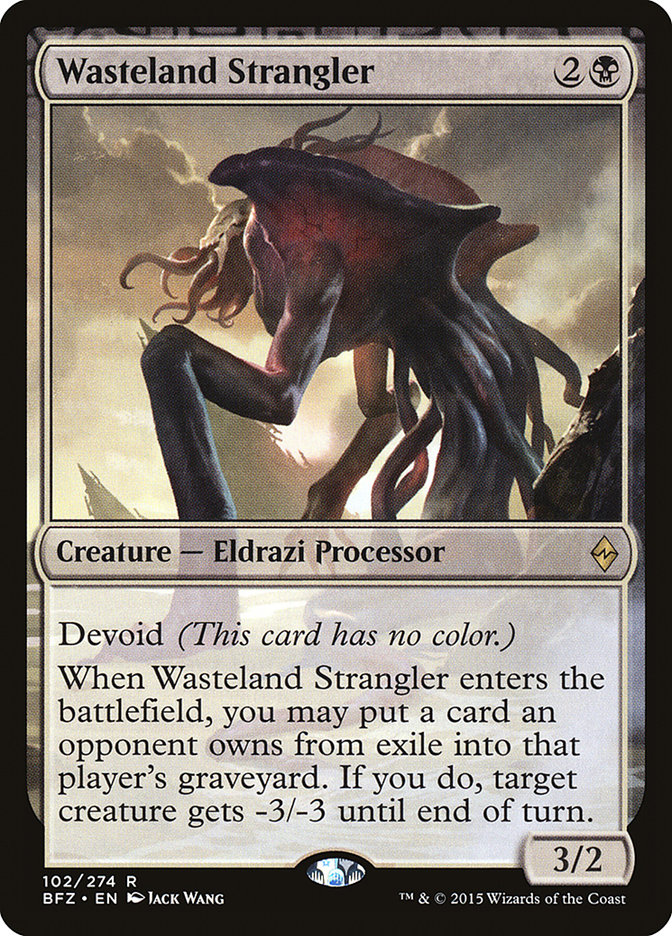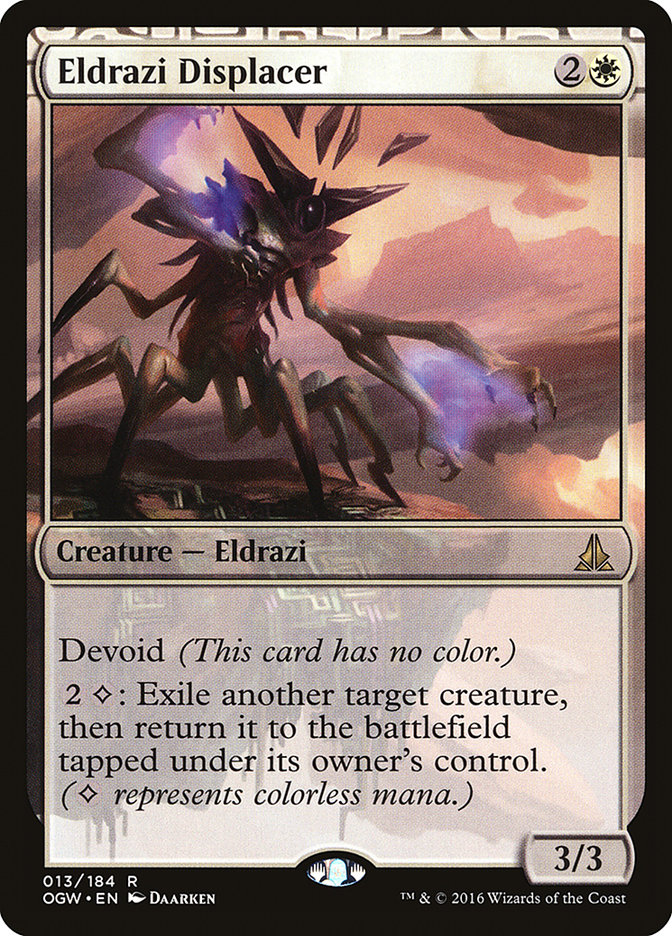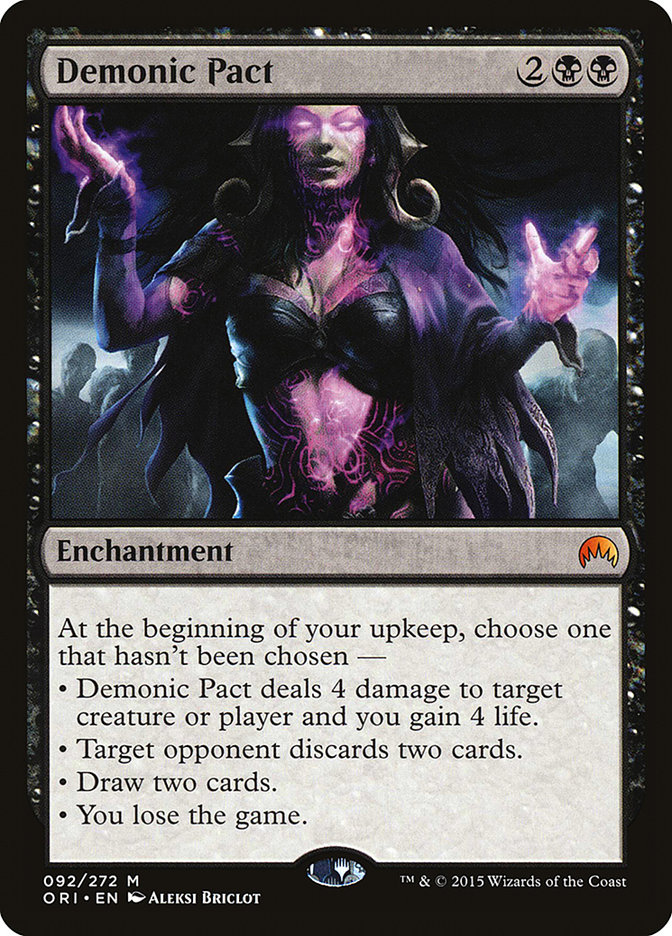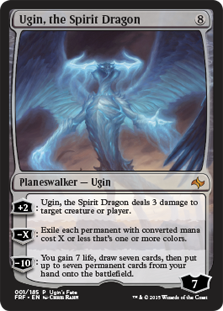Ulamog, the Ceaseless Hunger is no joke, but Battle for Zendikar wasn’t exactly overflowing with tournament-viable Eldrazi.
Oath of the Gatewatch, however, is full-on Eldrazi madness. It’s not just the big Eldrazi, like Kozilek, the Great Distortion or the various seven-drops that can all trigger Kozilek’s Return. Oath of the Gatewatch has a whole bunch of small- and medium-sized Eldrazi that are going to revolutionize multiple formats.
It always starts with Thought-Knot Seer. Yeah, a lot of lists are dedicated Eldrazi Aggro from the start, but you’re definitely going to start with a playset of the best one. However, it doesn’t take many games to see that Thought-Knot Seer actually is as insane as it looks. Vendilion Clique is just a 4/4 now, and they don’t draw a card unless they can kill it? What?!
Let’s see, why is Thought-Knot Seer good? Well, for starters, it’s a 4/4. How much does a 4/4 cost? Well, a 4/4 for 3 with no other abilities would see a lot of play, so I guess we’re paying 1 mana for the ability. How much is that ability worth? Well, Tidehollow Sculler was a great card, better than Isamaru, Hound of Konda, which it cost a colored mana (and a “hard” one at that, as it was a second color). How similar is Thought-Knot Seer to Tidehollow Sculler?
The ability on the Seer is better most of the time, with an important “weakness.” The reason it is better is because you looked at their hand and chose a card for them to lose. The odds are pretty decent that the card was a good card. At the very least, it was the best spell in their hand. If you Tidehollow Sculler them, killing the Sculler gives them back the card that was the best spell in their hand. If you kill Thought-Knot Seer, they draw a random card.
It’s not just the card quality, either. The ability to count on the card you are getting back from Tidehollow Sculler gives the opponent important information for several turns of what “they’re gonna draw” when they eventually kill the Sculler. If the Sculler hits a removal spell, it’s easy to kill the Sculler instead of a Dragon, since they know they’re going to get another removal spell for the Dragon that’s threatening to kill them. When the Thought-Knot Seer hits a removal spell, not only are they less likely to get a removal spell, they can’t count on it, so they don’t even try to kill the Thought-Knot Seer, which means they don’t even draw a card at all.
Most of the time, this is a great exchange for us, but there is a weakness. Some amount of the time our opponent’s hand will have nothing but land, or perhaps lands and dead cards. Even if there’s nothing for us to take, they still get to draw a card when the Thought-Knot Seer leaves play. In general, however, this is not enough of a risk to offset the incredible value of the ability.
This card is amazing, so good in fact, I keep wanting to just put in some non-Eldrazi decks. After all, there are plenty of ways to come up with colorless mana. The thing is, once I go to all the trouble, I often find myself looking at Reality Smasher…
Stormbreath Dragon was a 4/4 flier with haste with pretty solid upside. Reality Smasher is a 5/5 trample, haste, which I would argue is better, at least in Constructed. Reality Smasher may not have protection from white or the monstrous ability, but it does punish them no matter what color of removal they use on it. It remains to be seen exactly how good Reality Smasher will prove to be in the format (and in formats with Eldrazi Temple and Eye of Ugin), but I’m guessing the range is somewhere between great and insane.
Matter Reshaper is much easier for me to get away from than Thought-Knot Seer or Reality Smasher. It’s got a good rate and it looks like something worth doing, but contextually there are a lot of exile effects that bypass the ability (Silkwrap, Abzan Charm, etc).
Of course, if we’re playing full-on Eldrazi Aggro, this is one of the better ones to be playing in general. It’s a 3/2 for 3 that draws a card when it dies, which is already attractive; however, it also gives us a Black Lotus or a Mox acceleration some amount of the time. Does it reveal a creature that costs 3 or less? Free Black Lotus. Does it reveal a land? That land drops free, which is especially sick if our top card was a Shambling Vent and now we’re casting a Reality Smasher on turn 4 because of it!
While Eldrazi Mimic doesn’t demand we play it the same way Thought-Knot Seer does, it does lead to some pretty big beatings. It’s a little bit of a more highly variable Snapping Gnarlid, but if we are going down the colorless aggro path, it’s a fine reward. I do think the one toughness is going to prove a liability a surprising amount of the time (and not just because of Warping Wail, although that is part of the equation).
OK, OK. So Thought-Knot Seer, Reality Smasher, and Matter Reshaper need specifically colorless mana, and Eldrazi Mimic needs colorless creatures. How are we casting them?
Well, let’s start with the most pure, nulli-color aggro.
Creatures (24)
- 4 Hangarback Walker
- 4 Endless One
- 4 Eldrazi Mimic
- 4 Reality Smasher
- 4 Thought-Knot Seer
- 4 Matter Reshaper
Lands (25)
Spells (11)

Playing nulli-color means we get to make use of Ghostfire Blade if we want it, which is convenient, as we’re a bit short on one-drops. Endless One is something, but it’s a pretty lame one-drop. In general, we’re hoping to play a Ruins of Oran-Rief.
This is one of the biggest incentives to play colorless creatures in Standard, in my opinion. It’s going to let Eldrazi decks be much more efficient with their manabases. People can play more land, while also getting flooded less, since so many of the lands produce spell-like effects. Got an extra mana? Spend it powering up your threat. Don’t? No problem, just cast it as is.
Yes, it is like Oran-Rief, the Vastwood. That card was good, too, and that format was not about that sort of thing at all. That’s not what green was trying to do. Conversely, this is exactly what Eldrazi Aggro is looking to do, so it’s not even the biggest deal that Ruins of Oran-Rief is worded differently so as to not give all your creatures +1/+1 (a nerf they surely made because of how insane the card is with Hangarback Walker).
Isn’t it still good with Hangarback Walker?
Yes! Of course! It puts a +1/+1 counter on the Walker, making it sort of an Ancient Tomb when you have an odd amount of mana, but then it can also put a counter on a Thopter later.
Ruins of Oran-Rief is also a sweet combo with Eldrazi Mimic. You can respond to the Mimic ability by using the Ruins, so that even a second Mimic gives the first +1/+1 until end of turn. Generally, though, whatever you play gets bigger from the Ruins and the Mimic, so you are getting extra damage this turn on top of that.
I love that it’s an interesting question which removal spells to play, even in a colorless deck, and all of them kill Jace, Vryn’s Prodigy. Titan’s Presence is the most reliable (and with this many creatures, it’s pretty reliable); however, it does cost three. It’s also a potential liability with Sea Gate Wreckage, since it can get stuck in our hand.
Spatial Contortion is fast and efficient but can only kill relatively small things. That said, the ability to hit your own creatures is not trivial. Thought-Knot Seer and Reality Smasher can deal extra damage, while Hangarback Walker and Matter Reshaper could easily want to die, particularly in response to an opposing exile effect. It’s also worth noting that Spatial Contortion can be combined with Warping Wail to kill a lot of units that wouldn’t normally be legal targets (such as Thought-Knot Seer).
Warping Wail is the least reliable removal spell but has the added options of being a counterspell for sweepers and card-drawers like Painful Truths and Treasure Cruise, or ramp spells like Explosive Vegetation. It also makes a token at instant speed that can pick up a Ghostfire Blade and attack on your turn. An instant-speed blocker is also really interesting with Ruins of Oran-Rief. That the token can be sacrificed for mana means we can sometimes play a Reality Smasher out of nowhere, a turn earlier than our opponent was expecting.
Not that I think it’s the way to go, but just to get an idea of the options out here, here’s a sample colorless Eldrazi Ramp deck.
Creatures (18)
- 4 Hangarback Walker
- 2 Ulamog, the Ceaseless Hunger
- 2 Kozilek, the Great Distortion
- 2 Reality Smasher
- 4 Thought-Knot Seer
- 4 Matter Reshaper
Planeswalkers (4)
Lands (28)
Spells (10)

As you can see, we’re really not getting all that much compared to just playing green or whatever. By contrast, nulli-color aggro at least makes excellent use of its lands and appears to have a fast and consistent game plan. That said, there are a lot of good reasons to add one or more colors to the mix.
The first color that called out to me to use as a base for an Eldrazi aggro deck is black:
Creatures (28)
- 4 Bloodsoaked Champion
- 4 Hangarback Walker
- 4 Reality Smasher
- 4 Thought-Knot Seer
- 4 Bearer of Silence
- 4 Reaver Drone
- 4 Matter Reshaper
Lands (25)
Spells (7)

The most compelling “black” Eldrazi is Bearer of Silence because of the blend of power and versatility it brings.
This card is sort of like an easier-to-cast Gatekeeper of Malakir that is better for two mana but costs four to get full value out of. It’s worth noting, Bearer of Silence is an excellent choice for decks that are not all-in on Eldrazi. Even if you don’t draw a colorless land, you can still cast it as a 2/1 flier (that can’t block).
Grasp of Darkness is going to be awesome this time around. The loss of Bile Blight is felt very strongly in Standard and the printing of Spatial Contortion is only going to increase the desire for four-toughness creatures like Anafenza, the Foremost (and Thought-Knot Seer). It’s also much better at killing Siege Rhinos than Spatial Contortion (or Ultimate Price, for that matter), since it makes the blocking Rhino a 0/1, rather than a 7/2.
Ultimate Price is dramatically less appealing now, anyway. These Eldrazi decks are not good news for the card, and Eldrazi Ramp decks will likely be on the rise, too. It’s very possible the format settles back to a place that’s great for Ultimate Price, but I would be careful on Day 1.
The biggest challenge with using Grasp of Darkness in an Eldrazi aggro deck is the double black requirement, but if we’re playing Mono-Black, it’s not all that hard to get enough black, particularly since we’re typically going to want to play a creature on turn 2 anyway and can Grasp whenever we get around to it.
Unnatural Endurance is one of the most underrated cards in the entire set. Everyone underrated this card the first time around, in Theros block.
Remember when Boon of Erebos snuck up on everybody less than two years ago? It was such a great tempo trick and helped black decks with small creatures punch through big blockers. It was also an effective anti-removal measure, often countering three-mana spells for just a single mana.
Unnatural Endurance isn’t just a Boon of Erebos with devoid. Notice anything different amount the amount of life you have to pay?
Zero.
Unnatural Endurance takes a card that was powerful enough before and reprints it without the two life cost. Even in an aggressive deck, that’s a bigger upgrade than the difference between Unsummon and Vapor Snag. It’s not like we don’t value our life points. Hell, we have to. We spend them in so many places in this deck!
This is not just a Drown in Sorrow. Remember, because Flaying Tendrils exiles, it cancels out Hangarback Walker and Matter Reshaper, so use it with caution!
Bloodsoaked Champion isn’t on theme, but it’s not like we need to be overly slave to the theme. Yeah, it doesn’t help our Ruins of Oran-Rief, Tomb of the Spirit Dragon, or Reaver Drone. It’s still better than Sludge Crawler. Ghostfire Blade might be better, but Bloodsoaked Champion does look like the right type of effect to keep our beats coming.
Reaver Drone isn’t particularly attractive, but if we care about the whole colorless thing, it is a one-drop that isn’t embarrassing. This is another fine choice for a deck that isn’t “all-in.” After all, it’s basically still a Carnophage, and there are plenty of ways to offset the drawback some amount of the time. For instance:
Creatures (23)
- 4 Bloodsoaked Champion
- 2 Pitiless Horde
- 4 Despoiler of Souls
- 4 Hangarback Walker
- 1 Reality Smasher
- 4 Bearer of Silence
- 4 Reaver Drone
Lands (24)
Spells (13)

Dominator Drone is just a very mediocre Magic card, but it’s worth considering in some fringe cases. Generally, however, I’d like to not need to resort to such things.
Wasteland Strangler is a good card, but it takes you down a specific and different direction. In general, I would guess it’s more likely to be found in a B/W deck, taking advantage of stuff like Silkwrap, or Abzan with its Charge and Anafenza (at least in Standard).
Creatures (29)
- 3 Mardu Woe-Reaper
- 4 Wasteland Strangler
- 4 Eldrazi Displacer
- 4 Reality Smasher
- 4 Thought-Knot Seer
- 4 Bearer of Silence
- 4 Reaver Drone
- 2 Matter Reshaper
Lands (25)
Spells (6)

There are plenty of ways to exile, and if we wanted, we could push it even harder and go all the way up to Blight Herder. There are only so many five-drops you can play, though, so it’s not an easy puzzle. Besides, it’s not even clear if B/W is better than full-Abzan.
Creatures (23)
- 4 Siege Rhino
- 4 Hangarback Walker
- 2 Blight Herder
- 4 Wasteland Strangler
- 4 Eldrazi Displacer
- 1 Reality Smasher
- 4 Thought-Knot Seer
Lands (27)
Spells (10)

There’s a plethora of ways to build Abzan Eldrazi decks, depending on how aggressive you want to be, how synergistic with colorless or Eldrazi or processing you want to be, how planeswalker-heavy (perhaps with Oath of Nissa), how token-based, and how traditional.
Exile your Thought-Knot Seer during their draw step and you can filter their draws. If you’ve got the mana to fuel everything, this lets you make them draw the lesser of their top two cards (setting aside the possibility of instants, which is a big deal, but also predictable). This makes it hard for them to draw a Crux of Fate or Dragonlord Atarka.
Exile your Siege Rhino and you’re draining them out very quickly.
Exile your Wasteland Strangler, and you can kill more stuff (though hitting Blight Herder doesn’t do what you want).
Eldrazi Displacer can also just be an annoying way to protect your creatures, but where things get really fun is when you target your opponent’s stuff. Sure, it can Fog creatures every turn that are attacking you or remove potential blockers, but it’s just downright cruel against opponents with Hangarback Walkers. It can exile the Walker, giving them zero Thopters, and then bring the Walker back with zero counters.
It’s outside the scope of this deck, but you can exile a Brood Monitor from your side as many times as you want, killing basically anyone from any life total if you have a Zulaport Cutthroat or Flayer Drone.
This is another one that requires a very different direction in deckbuilding. It’s got a lot of power and I think there are some good homes to try, but it’s not the type of card you just throw into every random beatdown deck. Besides, it’s better placed in a more controlling deck that can really take advantage of the “selection” provided by its ability, filling its graveyard with removal spells (instead of spending those turns casting creatures).
I kind of feel like there’s a mono-black or largely mono-black control deck out there, but I don’t know what that looks like yet. Another possible home, however, is in a Demonic Pact deck, since bouncing the Inverter of Truth and replaying it gives us a new lease on life. Not only do we get a fresh reshuffle, we get to shuffle our Disperse back, ensuring we’ll never run out of cards.
Creatures (5)
Planeswalkers (2)
Lands (27)
Spells (26)

It’s also important to remember that if we draw two Inverters of Truth before casting one, we can sort of “go forever.” As long as we kill our Inverter of Truth before we run out of cards, we can use the other Inverter to keep the loop going.
Ugin, the Spirit Dragon may be a fair bit worse in the format; however, it is still an invaluable way to kill our Demonic Pact, and it might be sweet that our Inverter of Truth lives through the minus ability.
Dig Through Time can be a little dicey with Inverter of Truth, but at least it lets us improve the quality of cards in our graveyard so that when we do reshuffle, it’s nothing but the hotness.
OK, I’m out for today but will be back Monday. There are so many new decks to explore…
…you know, since there’s effectively a sixth color.


